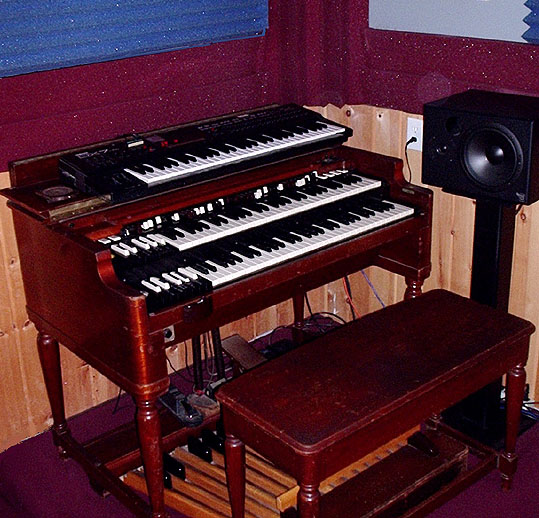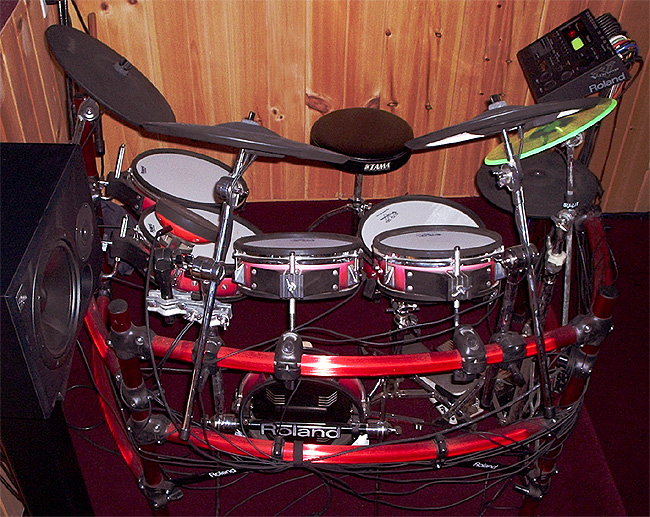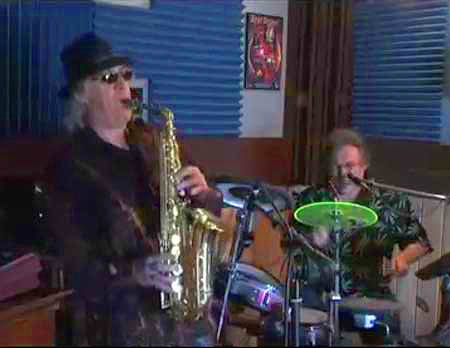
 |
Gearheads information page |
 Now with video info added! See below.
Now with video info added! See below.
Undoubtedly, those of you who have come across this page are interested in Hammond organs, music gear and/or recording. As such, Steffen Presley will be discussing his instruments and recording approach as it pertains to 3 Legs On Wheels debut CD, In Our Time Machine.
I bought my Hammond B3 in 1974. It was well used but thanks to a local organ technician put in good working order. I understand that this organ was probably made in the 1950s although it has never been determined which year. This organ is paired up with my Leslie 147 which I originally purchased years before and had originally used with a portable organ (Vox Continental). I've had this Leslie longer than any other piece of gear I still have. It was modified around 1980 with new speakers, specifically a JBL K145 bass speaker and an Electrovoice driver, which I consider a substantial improvement over the original Jensen driver and certainly more durable! The baffle in front of the horn was removed long enough ago for me not to remember when. The tube amp is the original and this unit is in superb working order. I had some modifications done to the Hammond a long time ago which amounted to adding some patch points, which I don't really use much today. The most significant mod I had done right from the beginning was adding a foot-switch to control the Leslie speed, which I use exclusively. You may notice that there is the usual half-moon Leslie switch in the photo. I had this added only within the last couple of years strictly to accommodate other organ players who might come to my studio to record.
After we had recorded the first two songs from our CD (see if you can guess which two), it became quite clear to me that I needed separate control of the bass pedals in the mix. I had Bill Axman from Alltek organ services in Los Angeles put in a separate output. This could only be done by tapping directly into the raw tone-wheel outputs before they get mixed at the pre-amp. This output was taken from the tone-wheels controlled by the 16' drawbar. The signal was too weak even with the channel trim control turned all the way up. I came up with an on the spot solution which was to activate the digital mixer console's channel compressor. I set the actual compressor controls (threshold, etc.) essentially off, so there would actually be no compression taking place, but set the make-up gain to about 20db, which provided an adequate and uncolored amplification. This signal was also very noisy, so I also placed a low-pass filter on it cutting all the way down to about 1kHz or so. This didn't affect the bass frequencies I was needing, so this proved to not be a compromise. I was able to store these settings as part of a mixer snapshot, which I could just call up for instant readiness every time we recorded a song.
What I wanted to achieve was a plucked or punchy bass-guitar like transient not normally present with the regular Hammond bass pedal sound, but similar to some add-on modifications such as the Kruger bass. But I wanted to retain the basic sound from the organ itself, not a fully synthesized replacement. The bass lines I'm doing are intended to be a full on replacement for a decent bass player, not just accents and not with my left hand as is far more common. Yes, I played left-hand bass for many years but this time I had something else in mind for the left hand; other organ parts or more often, playing complimentary sounds and parts on MIDI keyboard - a whole lot of dancing around! Since these bass parts required both feet, working the expression pedal to create dynamics wasn't possible. To get the sound I was after, for the next few songs we recorded, I ran the bass-pedal track through a Cubase VST plug-in, a brand new feature at the time, called "Dynamics". Essentially it is a threshold triggered envelope with a fast attack and decay. When mixing, I ran the track back through the Leslie 147 so it would again be blended in with the organ, but with separate control of level, EQ and of course the plug-in effect. In the last few songs we recorded, I started running the bass-pedal signal through my newly acquired Dave Smith Instruments - Poly Evolver. This did the same thing, a threshold controlled envelope trigger, but this time with filter envelopes and other effects to fatten the sound. In all of the songs I also had the 8' pedal drawbar about half-way out (only the 16' drawbar was going through the separate output), so that aspect of the bass-pedal sound was always a part of the organ track. This meant no editing, but editing individual notes was against the "live-performance" philosophy behind this album anyway.
Atop the organ I put my Yamaha DX7II as a master MIDI controller. I never used it's own sounds, choosing to control one or more of my other instruments. With one exception (the soprano sax sound in "Here and There") the synthesizers were never overdubbed, always recorded live with everything else. I deliberately kept these sounds fairly basic and complimentary to the Hammond and the song. Mostly I used clavinet or electric piano sounds, but would occasionally stretch to include some electronic timbres, especially from the Poly-Evolver. Instruments used on the album as played from the DX7II include a Kurzweil K2500XS, a Korg Karma a Studio Electronics modified Minimoog, a Yamaha VL1-m physical modeling synth and also a Roland V-Synth XT in Vocal Designer mode for the "background vocals" in "In Our Time Machine" and "Free Fall" (okay, being a "vocal" part, that was an overdub also). In "French Aire" I played my real Falcone acoustic grand piano. This is in a separate room and was therefore overdubbed.
 Frankly I don't know how we could have done this album without my expanded Roland V-Drums kit. From the start Arnold and I wanted to record a "live" album. This is difficult to do in the studio with regular acoustic drums because of the isolation involved (not to mention the space required and all of the elaborate set-up time involved). My studio has a stage area and we were able to set up sort of like at a club (but much smaller of course), with speaker monitors for each of us. We didn't have to wear headphones, instead hearing the music in the monitors very much as it sounds on the recordings and didn't have to worry about leakage! The Leslie speaker for the organ was miked in another room. The V-drums of course need no microphones which is a major advantage, allowing us to be in close proximity and even talk to each other during the recording with no worries of that picking up. Creating music instead of setting up drums, mics and spending an eternity getting a drum sound is a big advantage that is hard to argue against. And let me say right now that even though these drums are not acoustic, they are indeed "real" drums, played with the same techniques and responses. Anyone who disputes this simply has not sat down and played this kit! This even includes the ability to very accurately play with brushes, which we used quite effectively on the New Orleans inflected French Aire. Sure, there are some minor things that don't quite respond like acoustic drums, but by the same token there are very creative things you can do on the V-Drums that cannot be approached on an acoustic kit! A good example of this is the middle section of "In Our Time Machine" where Arnold changed "kits" to one in which the hi-hat pedal controls the pitches of all the drums and cymbals. A Lot of people might assume that was me on the synthesizer, but I was just holding down a pad sound (with a very long release) while playing the organ and working the drawbars to animate the harmonics. Of course Arnold has his own drums and was very open minded in using my kit, but fully understands and appreciates the advantages! In the beginning we spent a small amount of time choosing kits and customizing things to Arnold's preferences. We did not spend as much time on that as you may think though. Our priorities were arranging and playing the songs. Since we were making a live album, this required a fair amount of rehearsing.
Frankly I don't know how we could have done this album without my expanded Roland V-Drums kit. From the start Arnold and I wanted to record a "live" album. This is difficult to do in the studio with regular acoustic drums because of the isolation involved (not to mention the space required and all of the elaborate set-up time involved). My studio has a stage area and we were able to set up sort of like at a club (but much smaller of course), with speaker monitors for each of us. We didn't have to wear headphones, instead hearing the music in the monitors very much as it sounds on the recordings and didn't have to worry about leakage! The Leslie speaker for the organ was miked in another room. The V-drums of course need no microphones which is a major advantage, allowing us to be in close proximity and even talk to each other during the recording with no worries of that picking up. Creating music instead of setting up drums, mics and spending an eternity getting a drum sound is a big advantage that is hard to argue against. And let me say right now that even though these drums are not acoustic, they are indeed "real" drums, played with the same techniques and responses. Anyone who disputes this simply has not sat down and played this kit! This even includes the ability to very accurately play with brushes, which we used quite effectively on the New Orleans inflected French Aire. Sure, there are some minor things that don't quite respond like acoustic drums, but by the same token there are very creative things you can do on the V-Drums that cannot be approached on an acoustic kit! A good example of this is the middle section of "In Our Time Machine" where Arnold changed "kits" to one in which the hi-hat pedal controls the pitches of all the drums and cymbals. A Lot of people might assume that was me on the synthesizer, but I was just holding down a pad sound (with a very long release) while playing the organ and working the drawbars to animate the harmonics. Of course Arnold has his own drums and was very open minded in using my kit, but fully understands and appreciates the advantages! In the beginning we spent a small amount of time choosing kits and customizing things to Arnold's preferences. We did not spend as much time on that as you may think though. Our priorities were arranging and playing the songs. Since we were making a live album, this required a fair amount of rehearsing.
In Our Time Machine. This song, and the accompanying video, deliberately mixes the old school sound and vibe of the Hammond B3 organ and some of it's associated stylings along with modern sounds and production. In fact, the lyrics are referring to the historical place of the Hammond organ in music. There are certain things going on musically that not many people, even other musicians, are not likely to pick up on unless they read this. Certain aspects of the main parts of the song (verse, chorus and similar) are fairly obvious. Arnold is playing a drum kit on the Roland V-Drums that we set up to essentially take the place of an acoustic drum kit, sonically and performance-wise. The organ parts form the meat of the sound, with the bass parts done entirely on the bass-pedals at the same time. My left hand is playing a patch on a Korg Karma called "Neo Clav", during the main parts of the song. It is a modeled sound using the added MOSS expansion board (which gives the Karma the sound and capabilities of the famed Korg Z1). Although clavinet-like, it is deliberately an electronic synth sound, as we did not wish to get too retro with the production. This percussive sound was chosen to compliment the organ and somewhat serve the purpose of a rhythm guitar. It is a fairly thin sound and does not assist the pedal bass in any way, either sonically or part-wise. We obviously really change things up in the middle section. I switch sounds on the Karma to another modeled MOSS patch, this one called "Ocean Calm". It is actually based on an organ model, so harmonically it blends right in with the Hammond. This patch makes excellent use of band-pass filtering to form a very interesting slowly evolving timbre. There is also a lot of effects on this sound, so it sounds more synth-like than organ-like. The patch has a very long release, so when I remove my hand from the keyboard, the sound takes some time to die away. This aspect makes it kind of like having a third hand, such that as the Karma sound dies away, I'm quickly getting my right hand back on the organ while doing some serious drawbar manipulation with my left hand to create shimmering evolving textures on the organ, the whole thing creating pad like washes of sound. As this is going on, I set up a polyrhythmic motif using the organ pedals. The really interesting thing that is going on is with the drums. Arnold changes patches at the start of this middle section to another drum "kit" we have set up for this part of the song. Despite the patch change buttons being larger than silver dollars, Arnold found that changing kits to be a bit of a challenge, something drummers don't ordinarily have to do! The kit is called "Bend Me" and really shows off the capabilities of the V-drums which go far beyond acoustic drum emulation. The sounds themselves are a very interesting cross between acoustic and electronic which provides an organic yet unfamiliar character. The most unusual aspect however, is that the hi-hat pedal is programmed to affect the pitch of every drum. Although there is a similarity to a tympani in this aspect, rather than bend the pitches (despite the kit program name) we used it to create a new pitch every time a drum is struck. The effect is most prominent with the "cymbals" which actually have a sort of bell-like sound assigned to them. Arnold must then change the program back to the original kit going back into the reprise and solo sections. Likewise, I have to change the Karma back to its original patch and also change back to the drawbar preset used in the first part of the song. Particularly as this also meant transitioning out of a polyrhythmic section, this required a fair amount of rehearsal. Background vocals: In the video, you may notice an interesting looking device on top of my speaker monitor to the left of the organ. This is a Roland V-Synth XT set in "Vocal Designer" mode which works very similar to a vocoder, but with much greater capabilities. The V-Synth was connected via MIDI to the Karma. My microphone was plugged into the V-Synth instead of a PA, controlling the patches for the electronic vocals. So although you see me "singing" the parts, it is not actually me you are hearing. Moving on... So who is that sax player who suddenly shows up rather briefly? Okay that was not done live, it was dubbed in. For live performance we hire various musicians to fill that role in the band.
Manic Depression. Although we spent a great deal of time planning and rehearsing so as to create as authentic and respectful a Jimi Hendrix vibe as we possibly could, the keyboard parts are actually rather easy to play. Everything is in unison a lot of the time (a big reason the sound is so huge!). The synth keyboard used is the Dave Smith Instruments - Poly Evolver Keyboard, a truly fabulous and very current synthesizer with real analog circuitry. I'm using a couple of highly modified factor presets layered in combo mode set in Unison mode. In addition, a MiniMoog (which I've owned since the early 70's) and dramatically customized by Studio Electronics with MIDI, is is also controlled by the Poly-Evolver, playing an octave lower and yes enhancing the bass in no small way. In fact, unlike all of our original songs, the bass pedals weren't really necessary other than their important role during the solo, where I ducked the MiniMoog using an expression pedal, but they did contribute to the mighty phatt sound! The Poly-Evolver is the only synthesizer I've ever heard of which has a dedicated feedback control for creating real feedback (as opposed to simulated feedback). I brought this effect in and out using another expression pedal (yes, it gets confusing with all of the pedals down there and out of sight. See photos) Finally, it must be said how great a job Arnold did of using his best Hendrix voice while playing that cool 3/4 drumbeat!
![]() If you have any questions feel free to
If you have any questions feel free to
|
|
 |
 |
 |
|

|
| CD info | Band info |
Reviews & comments |
Photos | Song lyrics | Home |